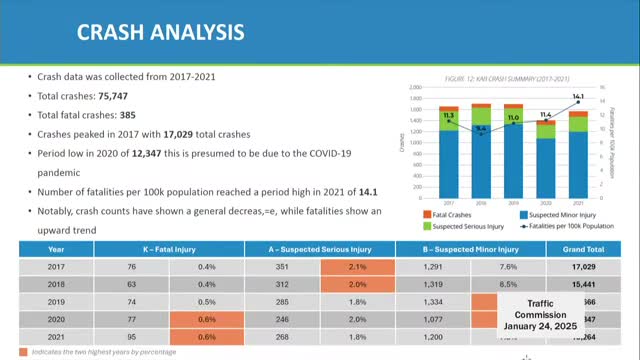Oklahoma City unveils data-driven traffic safety plan targeting high injury network
January 25, 2025 | Other Public Meetings, Oklahoma City, Oklahoma County, Oklahoma
This article was created by AI summarizing key points discussed. AI makes mistakes, so for full details and context, please refer to the video of the full meeting. Please report any errors so we can fix them. Report an error »

The Traffic and Transportation Commission of Oklahoma City convened on January 24, 2025, to discuss critical findings and recommendations from a recent analysis of traffic safety and crash data. The meeting highlighted a concerning trend: while overall crash counts have decreased, fatalities have risen over the past five years. This discrepancy prompted a detailed investigation into contributing factors, including roadway and environmental characteristics.
The analysis identified a "high injury network," which represents 6.6% of the city's total roadway network but accounts for 87% of all fatal crashes during the study period. This network will serve as a focal point for targeted safety improvements. The commission outlined seven study corridors, totaling 15 roadway miles, where specific countermeasures will be recommended for implementation.
The proposed safety countermeasures are categorized into three tiers. The first tier consists of systemic countermeasures that can be applied citywide to address general safety issues. The second tier focuses on targeted countermeasures within the identified study corridors, while the third tier includes conceptual designs for specific treatments at critical locations.
The commission emphasized the importance of using proven safety countermeasures from the Federal Highway Administration's database, which includes measures with established effectiveness in reducing crashes. A total of 27 action items were recommended, organized into five pillars aligned with the national safe system approach: safer people, safer roads, safer speeds, safer vehicles, and post-crash care. Each action item is categorized by its timeframe for implementation—short-range (less than two years), mid-range (two to five years), and long-term (more than five years).
To enhance transparency and public engagement, an interactive crash dashboard has been developed, allowing residents to view crash data and trends over the past five years. The dashboard includes filters that reflect the crash profiles discussed during the meeting.
Looking ahead, the commission plans to present these findings to the city council on February 11, with a vote for adoption scheduled for January 25. Additionally, the city aims to apply for a capital grant opportunity in March, which would fund the implementation of the recommended safety measures. The meeting concluded with an invitation for questions and comments, reflecting the commission's commitment to community involvement in traffic safety initiatives.
The analysis identified a "high injury network," which represents 6.6% of the city's total roadway network but accounts for 87% of all fatal crashes during the study period. This network will serve as a focal point for targeted safety improvements. The commission outlined seven study corridors, totaling 15 roadway miles, where specific countermeasures will be recommended for implementation.
The proposed safety countermeasures are categorized into three tiers. The first tier consists of systemic countermeasures that can be applied citywide to address general safety issues. The second tier focuses on targeted countermeasures within the identified study corridors, while the third tier includes conceptual designs for specific treatments at critical locations.
The commission emphasized the importance of using proven safety countermeasures from the Federal Highway Administration's database, which includes measures with established effectiveness in reducing crashes. A total of 27 action items were recommended, organized into five pillars aligned with the national safe system approach: safer people, safer roads, safer speeds, safer vehicles, and post-crash care. Each action item is categorized by its timeframe for implementation—short-range (less than two years), mid-range (two to five years), and long-term (more than five years).
To enhance transparency and public engagement, an interactive crash dashboard has been developed, allowing residents to view crash data and trends over the past five years. The dashboard includes filters that reflect the crash profiles discussed during the meeting.
Looking ahead, the commission plans to present these findings to the city council on February 11, with a vote for adoption scheduled for January 25. Additionally, the city aims to apply for a capital grant opportunity in March, which would fund the implementation of the recommended safety measures. The meeting concluded with an invitation for questions and comments, reflecting the commission's commitment to community involvement in traffic safety initiatives.
View full meeting
This article is based on a recent meeting—watch the full video and explore the complete transcript for deeper insights into the discussion.
View full meeting
